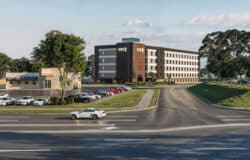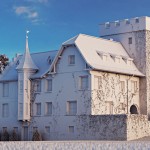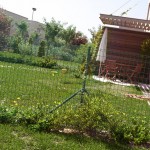Making of Sitting Area
Jason Lee posted a little fun side project he made not long ago on the forums – The ‘Sitting Area’. Today he shares a little about the process of making this 3d scene using Lightwave for modeling and rendering. I hope this will open up the door for more Lightwave users to share their work here as it looks like a very capable system and yet seems not so popular among archviz artists (is it?). Anyway, Jason get’s into some really great detail work in this scene we all can learn from… especially the extra push on adding details in postwork.
Jason is a Photographer/3D artist based in Memphis, Ohio. Doing 3D a little longer the photography he likes food and creating new things. Check out his online CG portfolio to see some of the other things his doing.
First off, I want to thank Ronen Bekerman for asking me to write this tutorial for his blog. I found this blog a few months ago and it has become a great resource of inspiration for me. Hopefully you will gain some insight into my Lightwave workflow after reading this.
Inception
The “Sitting Area” is a small project I created just for fun. As with most of my personal work I usually start by looking for inspiration and reference images online. I knew I wanted to create a space with white walls and a feeling of openness. I wanted the furniture to feel used and have texture. Sometimes I reference images for their “look”, and other times I will use them as reference for specific pieces. I use Lightwave 3d for all aspects from modeling to final render.
These are some of my reference images I found for this project.
Modeling
Most of the models in this scene are pretty simple. I like to try to model most of my furniture with subpatches in Lightwave. This allows me to control the subpatch level once I get to layout. If an object is close to the camera I can raise the subpatch level and it won’t break down. All the pieces in this room are subpatched, except for the table and obviously the walls, floor and windows. The flowers were created with Onyx and then brought into modeller where I put them in the vase. I try to have reference images for most of the furniture. When you can base your models on real life objects it really helps with filling in the details and making everything believable.
Here’s some wires of the main pieces.
Layout
After I get a few of the main pieces modeled I like to bring them into layout and start setting up my camera view. I think it’s important to figure out your final composition as soon as you can. This will let you see what you need to model and how detailed the objects need to be.
These are the different views I was experimenting with before arriving at the final.
I will usually setup a main camera angle first, and then when I get everything in the scene I will do some extra close-up views.
Lighting
For the lighting in this room I wanted the feeling of a bright overcast day without any direct sunlight in the room. The soft window light is the primary source. I don’t mind keeping the windows blown out as I think it helps with the feel. The scene is lit mainly by a luminous poly that I have right outside the window. I’m using final gather radiosity with 3 bounces to fill in the rest of the room. I added two small area lights inside the room as well. One of them helps fill in the chair, and the other one affects specular only. Luminous poly’s don’t affect specularity in lightwave, so you will have to add real lights in the scene if you want your surfaces to have spec highlights.
Here’s a layout view showing the lights and GI settings.
Surfacing
Most the items in this scene have texture maps in multiple channels such as reflection, spec, bump, and diffuse. I got a lot of the image maps from www.cgtextures.com, and then made spec/bump versions of them. Almost every surface has some amount of reflection, and most have blurred reflections. I like to use procedural textures as well. Putting a turbulence procedural in the diffuse channel at around 15% can really help break up surfaces and add realism.
Here’s some of the image maps I used. I created separate spec maps for the table and tabletop surfaces.
Postwork
I rendered the images to 32 bit HDRI’s so I could tone map them in post. I like to use Photomatix for tone mapping. Rendering to HDR is a great way to do exposure adjustments in post and get very photo-real results. After the tone-mapping I do some curve adjustments just to tweak the colors a bit. I also rendered out an ambient occlusion pass and multiplied it down at about 40%. This helps ground some objects and add a bit of shading to the corners…keep it subtle though.
Here’s an image showing the straight render on the left compared to the final.
I did a lot with the dodge/burn brush to add details to the surfaces. It saves a lot of time if you paint in the small detail in post and not try to UV map every little surface.
In these images you can see what a difference the paint over makes.
The final steps are adding a little vignetting in the corners and DOF using the DOF Pro plugin. I didn’t have depth maps, so I used the radial gradient and it worked fine.
Here’s all the final images again.
Thanks for reading, I hope it was helpful and you learned a few tips!
Jason’s original Sitting Area Forum thread
You are welcome to comment on this article and ask questions using the comment box below!




























it’s totally a picture! awesome!
Awesome! I loved the white balance and the small details!
testing…
Amazing work, Love those clean renders.
Great work! Thanks a lot for sharing it!
Great work!
The only thing that bothers me is the brick wall. It looks like those fake, vinyl walls that have a brick texture on it (unless this is what it is). But then again, brick textures are pretty hard to do in my opinion.
@kainfury I’ll have to agree with you on that – The bricks do look more like ceramic tiles the actual bricks. I use BRIX for doing that.
Wow… Thanks for sharing your work and tips
Wow…. thanks for sharing your work and tips
really great! the hardest part for me seems to be the post-burn/dodge-handiwork in photoshop. do you, or anybody else, have some advices/quicktips/links how to use these tools in a proper way? to me, it seems like painting, what i totally appreciate in a digital workflow…